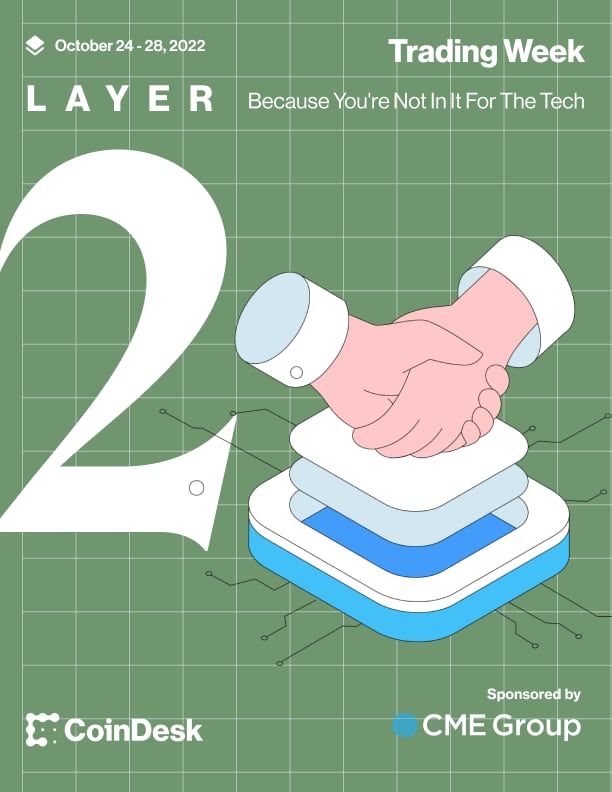Stablecoins: A New Key to Success in the Current Crypto Market
Speculation leads to innovation, but in a volatile bear market traders need stability.
:format(jpg)/cloudfront-us-east-1.images.arcpublishing.com/coindesk/ZN47TGUKEBDGXFKBWNKSPYU26Y.jpg)
You don’t need me to tell you that crypto is way down from the dizzying $3 trillion total market cap set in November 2021. The crypto space has contracted significantly over the past year, to put it lightly.
Some are calling it another “crypto winter” – a prolonged bear market that the blockchain world has seen several times before. Market actors bemoan this fact of life, but winter is a metaphorical chance for rebirth and renewal.
Daniel Cawrey, the author of O'Reilly Media's “Mastering Blockchain,” has been a contributor to CoinDesk since 2013. This feature is part of CoinDesk's "Trading Week."
In this frigid cycle it seems the stablecoin sector, and U.S. dollar coin (USDC) in particular, is emerging as something real, tangible and useful. These fiat-pegged assets are filling a role cryptocurrencies have always needed for long-term success – stability, for traders and new entrants alike.
Stablecoins are cryptocurrencies that are pegged to some kind of (relatively) stable asset. They are not free floating like bitcoin and ether. But because stablecoins are still based on cryptography and blockchain, they provide an alternative design space to traditional banking systems.
In theory, a stablecoin could be based on any relatively stable asset – like gold. But the most popular stablecoins are tied to the U.S. dollar.
Also part of Trading Week: Jeff Wilser - A Day in the Life of a Crypto Trade
The demand for stablecoins originally came from the lack of actual dollars in the crypto ecosystem, according to Circle Vice President of Product Joao Reginatto.
“One hundred percent of the utility of [stablecoins] is around on- and off-ramps into crypto capital markets,” said Reginatto, who was a part of the company’s efforts to launch USDC in 2018. “Four years ago … there was this huge demand from traders all around the world to get access to a good dollar form factor.”
USDC, and other stablecoins, “rode that wave,” Reginatto said. Today, after the emergence of a number of novel blockchain subsectors, the current pulling capital into stablecoins has only grown stronger. Decentralized finance (DeFi) is one example – a sea to crypto’s ocean.
Also part of Trading Week: Noelle Acheson - Why Trading Is Essential for Crypto
The emergence of lenders and exchanges using smart contracts, including Compound and Uniswap, needed some kind of stable asset to properly function. Stablecoins, and USDC in particular, are used to pair trades on decentralized exchanges, as both collateral and loaned capital on lending platforms and even as ballast for other, more experimental stablecoins like Maker’s DAI.
“The first time that we started seeing us occupying a leadership position was in DeFi,” Reginatto said, referring to the long-standing battle with Tether’s USDT stablecoin for market dominance.
The significant growth of DeFi beginning in mid-2020 led traders down a new path towards permissionless financial activities. An entire ecosystem has developed around trading, swapping and lending by using blockchain and smart contracts – largely bypassing centralized exchanges entirely. None of this would really be possible or profitable without stablecoins.
Stability in hard times
So where do things go from here? Well, crypto is finding stability in hard times. Bitcoin has been less volatile than the stock market, of late. That wasn’t always the case during bear markets – and it’s entirely possible the billions upon billions of dollars that have flowed into stablecoins are acting as a store of value this time around.
And while USDT, USDC and DAI are off their peaks set in 2021, Reginatto notes that the stablecoin market hasn’t deflated as much as crypto has overall. This paradigm may be helping bellwether assets like bitcoin fare better than in prior crypto downturns.
Also part of Trading Week: Marc Hochstein - The Art of Trading Without Trading
“Early this year [stablecoins] contracted by about $50 billion as a sector, which was around a 25% contraction,” he said, comparing it to the 80% drop seen in broader crypto capital markets. “It just shows that where there is utility, there is stickiness.”
This stickiness is a sign that stablecoins could lead crypto market growth when things rebound. That, of course, depends on continued adoption and innovation, which doesn’t seem to have slowed just yet. USDC, for example, is being tested out by payments companies such as Visa and Mastercard, allowing users to settle globally in the dollar.
And it’s not like dollar demand is slowing during this post-COVID-19, stagflationary era. No matter what you think of U.S. dollar hegemony, USD demand is surging across the global south and even the European Union. The difference with stablecoins, compared with other dollar proxies printed by credit companies and banks, is that these systems are accessible to anyone with an internet connection.
Or, as Reginatto put it, stablecoins are “neutral pieces of infrastructure” that can be plugged into any number of crypto and non-crypto applications.
There’s long been talk of crypto being “programmable money” or “money Legos,” the idea that with the right technical infrastructure software can stack on top of itself and build entirely novel programs. The concept has been rocked by crypto notorious volatility, but finally has a stable base on which to stand.
Remember, stablecoin came out of demand from traders and speculation. But sometimes, speculation is innovation.
“Everybody needs a dollar. The use cases are almost infinite,” Reginatto said.

:format(jpg)/www.coindesk.com/resizer/Xa9bNvs5kZ70JXYqqHRptLr2QX4=/arc-photo-coindesk/arc2-prod/public/2C4RDKFWXBH3TGP6BYYHAF267M.jpeg)